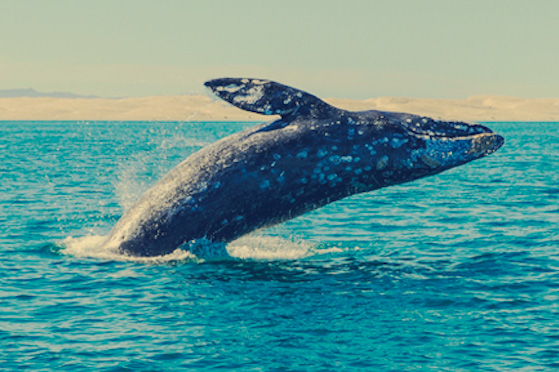GREY WHALE
The grey whale (eschirichtius robustus) travels more than 10,000 miles each year from Alaska to the lagoons on the coasts of Baja California Sur, avoiding radical temperature changes and swimming against the clock since it is in these lagoons where they will give birth and mate.
Grey whales swim very close to the coasts and this proximity has been either a tragedy for these creatures but also their salvation. For the last 150 years the grey whale has been twice in danger of extinction due to the overexploitation by whale hunters, however this proximity to humans has allowed naturalists and ocean biologists to study and learn more about the whales ‘habitat and behavior which are key pieces of information to enhance their conservation and protection.
It is known as grey whale for its opaque coal grey color of its skin. They eat mostly krill that dwells at the bottom of the sea for which the whale needs to use its snout to remove the sand to catch the krill with their baleen plates.
The grey whale (eschirichtius robustus) travels more than 10,000 miles each year from Alaska to the lagoons on the coasts of Baja California Sur, avoiding radical temperature changes and swimming against the clock since it is in these lagoons where they will give birth and mate.
Grey whales swim very close to the coasts and this proximity has been either a tragedy for these creatures but also their salvation. For the last 150 years the grey whale has been twice in danger of extinction due to the overexploitation by whale hunters, however this proximity to humans has allowed naturalists and ocean biologists to study and learn more about the whales ‘habitat and behavior which are key pieces of information to enhance their conservation and protection.
It is known as grey whale for its opaque coal grey color of its skin. They eat mostly krill that dwells at the bottom of the sea for which the whale needs to use its snout to remove the sand to catch the krill with their baleen plates.
The grey whale carries the heaviest and most complex load of crustaceans and parasites than any other cetacean. At a glance one can spot hundredths of small invertebrates that live stuck on the whales ‘skin forming small triangular white humps known as balanus.
The grey whale watching season starts mid December through late April, however there could be some small variations depending on each municipality.
In the municipality of Mulege it is possible to watch the whales in the Vizcaino Biosphere Reserve, Ojo de Liebre lagoon, San Ignacio lagoon and Punta Eugenia from early December to late April.
In Adolfo López Mateos Port, San Carlos Port, Santa María Bay and Magdalena Island in the municipality of Comondu; and in Puerto Chale and Magdalena Bay in the municipality of La Paz it is possible to watch whales from early January to late April.
For the whales’ safety, it is of vital importance that each visitor follows the protocols provided by the authorized tour suppliers running the whale watching tours.

STOPS








